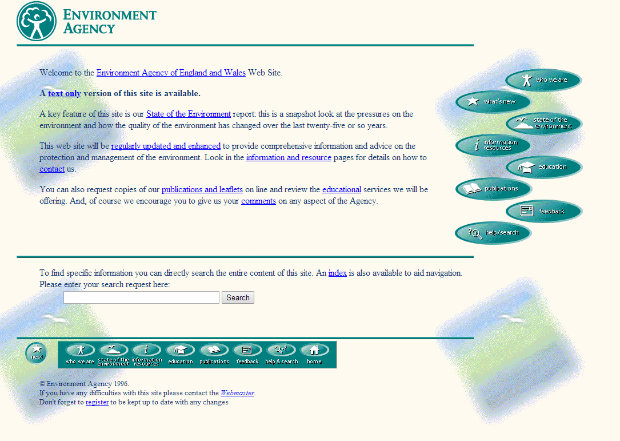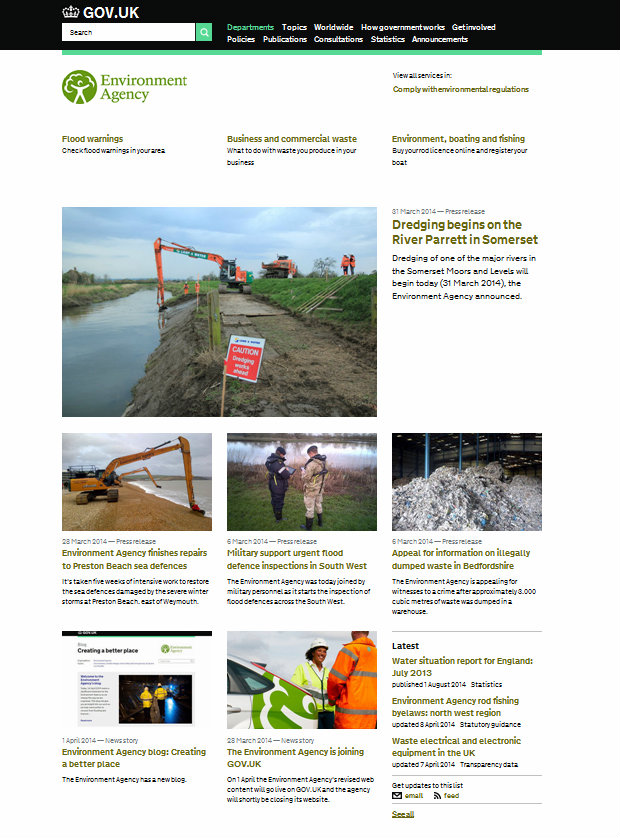Today our website moves to gov.uk. This means that online information will be simpler, clearer and easier to find.
We’re closing down our old website. But don’t worry – any content which didn’t make the move to GOV.UK will still be available via the National Archives website.
Our website has gone through many changes since it launched in 1996. A look back through the archives shows how, with the development of new digital technologies, our online services have changed.
Live flood warnings, online consultations, social media and video streaming were allusive concepts when the Environment Agency was first created. Now they’re an integral part of the service we offer to our customers and we can barely imagine how we coped without them.

The rate of change has been astounding – during the last three months over 7 million people visited the Environment Agency website. It is the source of live flood warning information for communities, businesses, journalists and emergency services across the country. It also provides vital services to farmers, industry and landowners who complete thousands of online transactions through the Environment Agency every day. Each and everyone of these services means that our customers know what to do to protect and improve the environment.
In the last couple of years we’ve extended our digital services to provide live flood alerts via Facebook, Twitter Alerts, video content and live web chats. All of these services rely on reliable, accessible content on our website.
Moving to GOV.UK has accelerated this development. We’ve reviewed and rewritten thousands of pages of content to make it more accessible, mobile friendly and easier to understand.

All of the information on GOV.UK must meet the needs of our customers. Our popular online services won’t change. This includes flood warnings, the electronic public register and consultations. We’re also moving our ‘What’s in your backyard?’ tool which gives you access to maps showing your local environment, pollution levels, flood risk, sites of interest and river levels.
Today’s move is the culmination of a year-long project which has seen us re-evaluate the way we share information online. Over 75 online services have been moved to GOV.UK.
And it doesn’t end here. Further improvements are being planned to make our information more accessible and user friendly. If you have any ideas for how we can continue to improve our digital services, tweet us @EnvAgency or leave a comment for gov.uk.
Pam Gilder is the Environment Agency’s Director of Corporate Affairs. She oversees our communications, media and business planning teams.

11 comments
Comment by wendy posted on
Noooo!!!!!!!! The EA website was annoying and the search facility was rubbish but the gov.uk is even more difficult to use and finding what you need is almost impossible. Deeply disappointed. You have made the working lives of lots of professionals so much more difficult.
Comment by Environment Agency posted on
Hello Wendy, The move to Gov.Uk is part of a national move for hundreds of government websites. Using a search on the landing page of Gov.Uk may prove to be the most effective way to search for a topic or alternatively a web search using Environment Agency and then the topic of your preferred search. Feedback will always be appreciated especially during these very early stages of the move on how the move to the new website has affected you or your Organisation. ^Eileen
Comment by Tom Beavis posted on
I note that whereas previously details of all the preliminary flood risk assessments were provided these are not linked on the new website. When you search for PFRA's you get a link to an archive site and this simply returns an error when you click on the relevant PFRA. Is there a program to transfer the PFRA links and if so when is this likely to be completed?
Tom Beavis
Comment by Environment Agency posted on
Hello Tom, Please find the link that will take you to our webpage for preliminary flood risk assessments: https://www.gov.uk/search?q=preliminary+flood+risk+assessment. If you can copy and paste into your internet search engine as this blog does not allow navigation links to operate. ^Eileen
Comment by Sue Beck posted on
Would like to thank you for clearing the sunken boats from St Albans Riverside at Hampton. No illegally moored boats at present. So nice to see the general public enjoying the space in the summer - walking, sitting on the bank eating icecreams or whatever and enjoying looking out at the river and what an impovement to my view. Long may it last! Sue Beck.
Comment by Ander posted on
So where have you moved "What's in my backyard?" to. The hyperlink lands you on https://www.gov.uk/check-local-environmental-data
This page does not appear to contain this information, and google doesn't offer up a link either.
Comment by eileenroffe posted on
Good afternoon, this article was published in 2014 as What’s in my backyard IT platform needed updating. Environmental data is available online from alternative sources. These sources collectively replaced the What's In Your Backyard (WIYBY) service on GOV.UK.
The Defra Data Services Platform has also been launched where customers can search for data and access a customer forum. https://environment.data.gov.uk/
Another information platform is: https://www.data.gov.uk/
You can also email us at: enquiries@environment-agency.gov.uk to as for information requests
^Eileen
Comment by terry posted on
where is the "whats in my backyard" search gone to? The link goes to EA web page and then nothing!
Comment by eileenroffe posted on
Good afternoon, The What’s in Your Back Yard (WIYBY) service has provided environmental data on maps to members of the public for nearly 20 years. But in recent years the service has been running on out of date technology and software, which meant that the service had been running at significant risk of failure. The service was withdrawn at the beginning of April as we were no longer able to keep the maps and data up to date. We have been working to make data previously available through WIYBY available through other sharing services such as DATA.GOV.UK, MAGIC map and new GOV.UK digital services. ^Eileen
Comment by henry posted on
Local historian here and the removal of the What's in my Backyard feature is a significant, if not horrific loss of important public data. The reason being, the development of historic tips will now happen or nearby them. Was this a purposeful move by government? It seems so!
C'mon folks - where is the my backyard map now?
Comment by Pamela Woodthorpe posted on
The removal of WIYBY is quite frankly a shocking decision.
This was utilised for many years by professionals to ensure adequate monitoring for brownfield sites, identifying potential pollutants & risks. Removing this without a replacement is simply a backward step.